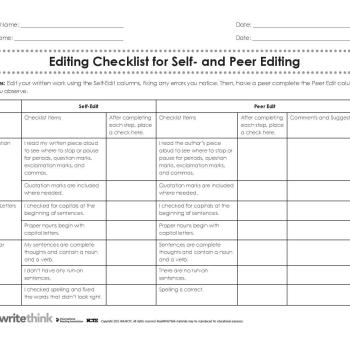Editing Checklist for Self- and Peer Editing

About this printout
This helpful tool will give your students the opportunity to edit their own writing and then observe as their peers edit the same work.
Teaching with this printout
Before you begin, be sure to model and discuss each step of the writing process (prewriting, drafting, revising, editing, and publishing), preferably using a whole-class story or class newsletter article. Please note that the revising stage precedes editing. Student should have already worked through content revisions before reaching the editing step.
When they are ready for the editing stage of the writing process, students should edit their writing and then meet with a partner to engage in peer editing. Prior to having students use this tool independently, it is important to model its use. To do this, display sample text on an overhead projector, document camera, or SMART Board so that all students can view it. Model the use of the self-edit column with the displayed text, with you assuming the role of author. Then have a volunteer fill out the peer-edit column so that all students can hear and view the process. Finally, discuss what went well and what could be improved in the editing steps that were modeled.
This tool serves multiple purposes, including:
- The self-edit step
- encourages students to evaluate specific features of their writing, increasing self-awareness of writing conventions
- keeps the pen in the writer’s hand for the initial editing phase
- The peer-edit step
- helps build a learning community in which peers work collaboratively
- heightens the awareness of various print and grammatical conventions for the peer editor and the author
More ideas to try
- Use a fish-bowl technique to allow the class to view a self- and peer-edit session of two of their classmates. To do this, first choose one student to model the self-editing phase. It is helpful to select a student who has a good understanding of the criteria on the rubric, such as proper grammar and punctuation. That student works through the items in the self-edit column as the other students observe. It is helpful to put the editing checklist on an overhead projector or document camera so all students can see the process. After the self-edit is complete, discuss the process with the students. Next, choose another student to serve as the peer editor for the piece that was just self-edited. Have the two students sit in the middle of the class so that all students can see and hear them as they work through the peer-editing phase. Afterward, include the entire class in a discussion about the process itself and ways in which the editing session will help the author and peer editor improve on their writing.
- Have students work in groups of two or three to edit one piece of writing. The interaction between peers will help make the editing process more explicit. While the students are working in groups, move from group to group to check their understanding of the editing process and use of the checklist. Try to notice groups that lack comments in the “Comments and Suggestions” columns and encourage them to use this section to provide feedback to the writer, particularly for criteria that lack a check mark. To guide them, you could ask, “What do you think you could write in the ‘Comments’ section to help the writer fix this error?” Be sure to tell students that if they are unable to mark a check in the “After completing each step, place a check here” column, they must indicate the reason why they cannot check it in the “Comments and Suggestions” column.
- Regularly review the editing process by using samples of students’ work or your own writing samples. Assess students’ progress of the editing process by creating a simple checklist. List all students’ names down the first column and a row for dates on which the editing checklist was used across the top. Then, as you observe students during the editing process, you can rate their level of effectiveness as an editor by using simple marks, such as:
NO = Not Observed (use this for students you did not get to observe on that date)
+ = exceeds expectations
√ = meets expectations
- = below expectations
Student Names Date 1 Date 2 Date 3 Date 4 Student A Student B
If you notice a student who receives a “below expectations” two times in a row, you can have him or her work with a peer who typically scores “above expectations” to model the process for him. - If your school uses a team approach for grouping students (a group of students who all share the same content area teachers), consider encouraging other team teachers to use this checklist in their respective content areas. Consistency in the editing process will help students understand that the editing process can apply to all written pieces, regardless of the content area.